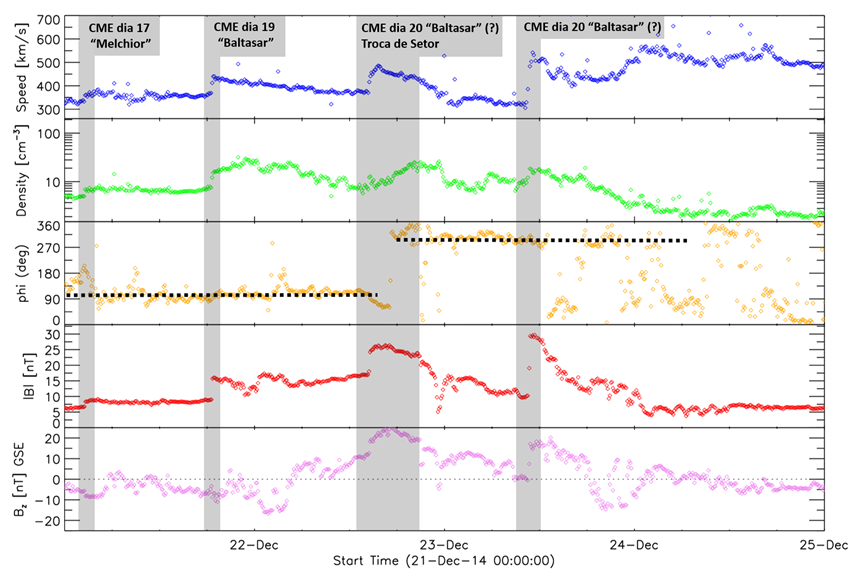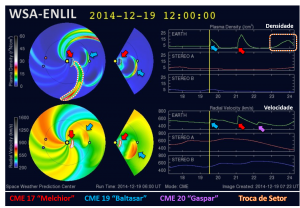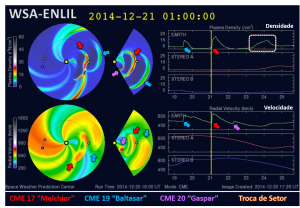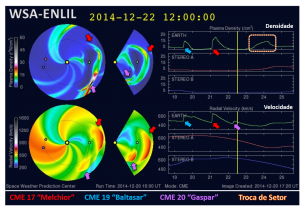Authors: Rafael R. S. de Mendonça, Carlos R. Braga
As well as the Three Magi Kings, three coronal mass ejections (CMEs) left their birthplace (the Sun) and passed the Earth during the last Christmas. The first CME (Melchior) was ejected on day 17th, the second (Balthazar) on 19th and the third (Caspar) on 20th of December 2014.
CMEs are huge amounts of mass ejected from the Sun. They are formed by electrically charged particles and they have a closed magnetic field structure with higher strength then usually observed in the interplanetary medium. Although they are observed with daily frequency (depending on the solar cycle phase), many coronal mass ejections are not directed toward the Earth) and do not produce any effect on the magnetosphere of the Earth. However, when they are directed toward the Earth, they are the main source of intense geomagnetic storms, which, among other effects, may cause drag onboard satellites or problems in the electric power grid.
In the similar way the Three Magi Kings, the 3 CMEs ejected on the week before Christmas were very humble and did not have much brightness when observed by coronagraphs close to the Sun. A coronagraph observes white light scattered by free electrons located in the solar corona, a process called Thompson Scattering. In many cases (see the CME from October 28th 2003 observed onboard the SOHO spacecraft, Figure 1) this brightness is very high. The Three Magi Kings (see the rightmost three panels in Figure 1), on the other hand, had a low brightness.
Figure 1. Example of a coronal mass ejection with intense brightness (the leftmost panel) and the three others observed on the week before Christmas in 2014. The solar surface (indicated by the white circle) and the region close to it are covered by an occulter.
Source: http://sohodata.nascom.nasa.gov/cgi-bin/data_query
None of the three CMEs were ejected exactly toward the Earth and, even though, its effects were observed in the interplanetary medium and the Earth’s magnetosphere. In opposition to the Magi Kings, they did not left gold, incense and myrrh. They caused an enhancement in the interplanetary magnetic field, in the particle density and in the solar wind speed observed close to the Earth.
As we can see in the data from the WIND spacecraft (Figure 2), the “gifts” were delivered before Christmas. “Melchior” left its “gift” on the first hours of day 21 and “Balthazar” at the last hours of the same day. Both produced an increase in the solar wind speed, in the proton density and in the magnetic field intensity observed close to the Earth. The enhancements observed by the second event were higher than those produced by the first one. The arrival time of “Gaspar” is still under discussion whether it arrived on the last hours of day 22 or on 23 close to midday. As shown by the regions in gray in Figure 2, the magnetic field intensity observed in these two periods was much higher than the observed during calm periods. Furthermore, it was one of the highest in 2014. In each period, the solar wind also had an increased speed.
Figure 2. Observation of the interplanetary magnetic field parameters between December 21st and 24th 2014. In these days, the effects of the coronal mass ejections were detected in the interplanetary medium close to the Earth.
Despite the interplanetary magnetic field enhancement due to these CMEs, its configuration was not very favorable to produce geomagnetic storms. Its component aligned with the “z” axis from the GSE (Geocentric Solar Ecliptic) coordinate system did not have long-lasting negative values. This fact is unfavorable to produce intense geomagnetic storms. Despite of this, at least one was observed between December 21 and December 25.
Data from the WSA-ENLIL model, widely used the scientific community to study solar wind as well as coronal mass ejections and, forecasted the arrival of “Melchior” at day 19, of “Balthazar” on day 21 and “Caspar” on the first hours on day 22. The first CME arrived more than 24 hours after the predicted time (Figure 3), the second at least 6 hours after (Figure 4). The third CME may have arrived 12 or 24 hours later than the predicted (Figure 5), depending of which perturbation on the interplanetary medium it caused (the one on the last hours of day 22 or other on day 23 close to midday). According to these models, the third CME would not hit the Earth directly in a way that changes in the solar wind density were not expected. Only the effects of the shock wave were expected, characterized by a sudden increase in the solar wind speed.
Moreover, an increase in the solar wind density was expected due to a Heliospheric current Sheet Crossing. This structure consists of a sudden change in the direction of the “x” and “y” components of the interplanetary magnetic field. This inversion is related to the approximately dipolar solar magnetic field and the inclination of the dipole axis in relation the ecliptic plane. It is observed, on average, every 7 days. The previous Heliospheric Current Sheet Crossing had been observed on December 12 2014 (approximately 11 days before). In Figure 2, “phi” is the angle between the “x” and “y” components. Notice that it was close to 90 degrees up to midday of December 22nd. After this, the angle suddenly changed to approximately 270 degrees, this defines the Heliospheric Current Sheet. In this way, the perturbation observed on day 22 may be related to the sector crossing instead of the third CME. If this is confirmed, the disturbance related to the third CME would be the one observed on December 23rd. Thanks to a shock wave associated to the CME, “phi” is unstable from this period on.
Figure 3. A model of the interplanetary medium showing the speed and density of the solar Wind no December 19th 2014. The Sun is represented in yellow and the Earth in green. One can notice that the perturbations related to the passage of “Belchior” (ejected on day 17) and “Balthazar” (ejected on day 19). Source: http://www.swpc.noaa.gov/products/wsa-enlil-solar-wind-prediction.
Figure 4. A model of the interplanetary medium showing the speed and density of the solar Wind no December 21st 2014. The Sun is represented in yellow and the Earth in green. One can notice that the perturbations related to the passage of “Belchior” (ejected on day 17), “Balthazar” (ejected on day 19) and “Caspar” (ejected on day 20). Source: http://www.swpc.noaa.gov/products/wsa-enlil-solar-wind-prediction.
Figure 5. A model of the interplanetary medium showing the speed and density of the solar Wind no December 22nd 2014. The Sun is represented in yellow and the Earth in green. One can notice that the perturbations related to the passage of “Balthazar” (ejected on day 19) and “Caspar” (ejected on day 20). Source: http://www.swpc.noaa.gov/products/wsa-enlil-solar-wind-prediction.
Further studies and analyses are necessary do understand not only the CMEs observed on the days before Christmas but many similar events. The current available model still lacks precision and many questions still need to be answered. Some phenomena still need to be simulated to allow us a precise forecasting of the CMEs arrival time. Forecasting the consequences on the Earth caused by each CME is even more complicated. Understanding through the scientific method what each Magi King is, how they travelled and what happened to them is still a challenge.










